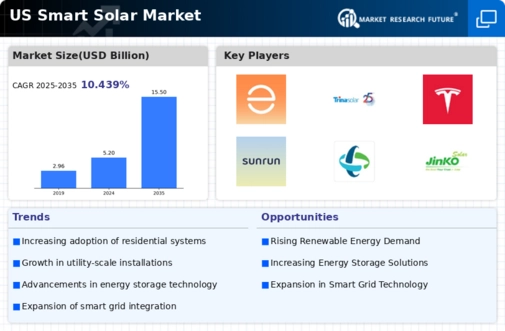Rising Energy Costs
The smart solar market is being propelled by the rising costs of traditional energy sources. As fossil fuel prices fluctuate and often increase, consumers and businesses are seeking alternative energy solutions. In 2025, the average residential electricity price in the US has reached approximately $0.14 per kWh, prompting a shift towards renewable energy sources. Solar energy, particularly when integrated with smart technologies, offers a viable solution to mitigate these costs. By investing in solar systems, users can potentially reduce their energy bills by up to 50%, depending on their location and energy consumption patterns. This economic incentive is driving more households and commercial entities to adopt solar solutions, thereby expanding the smart solar market. The financial benefits associated with solar energy adoption are likely to continue influencing consumer behavior and market dynamics.
Regulatory Framework and Policy Support
The smart solar market is significantly influenced by the regulatory framework and policy support provided by federal and state governments. In 2025, various incentives, such as tax credits and rebates, are available to encourage solar adoption. The federal Investment Tax Credit (ITC) allows homeowners and businesses to deduct a substantial percentage of the cost of solar systems from their federal taxes. Additionally, many states have implemented Renewable Portfolio Standards (RPS) that mandate a certain percentage of energy to come from renewable sources. These policies create a favorable environment for the smart solar market, making solar installations more financially attractive. As regulatory support continues to evolve, it is likely to stimulate further growth in the market, encouraging more stakeholders to invest in solar technologies.
Increased Demand for Energy Independence
The smart solar market is witnessing a surge in demand for energy independence among consumers and businesses. As energy security becomes a priority, many are looking to reduce their reliance on traditional energy sources. In 2025, a notable trend shows that over 60% of consumers express interest in generating their own electricity through solar power. This desire for self-sufficiency is driving the adoption of smart solar technologies, which enable users to monitor and manage their energy consumption effectively. The integration of battery storage systems allows for energy storage during peak production times, providing users with greater control over their energy usage. This trend towards energy independence is likely to continue shaping the smart solar market, as more individuals and organizations seek to harness renewable energy for their own needs.
Technological Advancements in Solar Energy
The smart solar market is experiencing rapid technological advancements that enhance efficiency and performance. Innovations such as bifacial solar panels and energy storage systems are becoming increasingly prevalent. These technologies allow for greater energy capture and utilization, which is crucial for maximizing solar energy output. In 2025, the efficiency of solar panels has improved to an average of 22%, indicating a significant leap from previous years. Furthermore, the integration of artificial intelligence and machine learning in solar energy management systems is optimizing energy consumption patterns. This trend not only reduces costs but also increases the reliability of solar energy systems, making them more appealing to consumers and businesses alike. As these technologies continue to evolve, they are likely to drive growth in the smart solar market, attracting investments and fostering competition among manufacturers.
Environmental Awareness and Sustainability Goals
The growing emphasis on environmental sustainability is significantly influencing the smart solar market. As awareness of climate change and environmental degradation increases, both consumers and corporations are prioritizing sustainable practices. In 2025, a survey indicates that over 70% of US consumers are willing to pay a premium for products that are environmentally friendly. This shift in consumer behavior is encouraging businesses to adopt renewable energy solutions, including solar power. Companies are setting ambitious sustainability goals, with many aiming for carbon neutrality by 2030. The smart solar market is positioned to benefit from this trend, as solar energy is a clean and renewable resource. The alignment of solar technology with sustainability initiatives is likely to attract investments and partnerships, further driving growth in the market.






















Leave a Comment